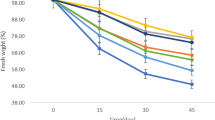Abstract
The quality of tomato fruit and juice (Lycopersicon esculentum L. cv. VF M82-1-8) grown in an aerohydroponic system in a greenhouse was affected by the level of Cl− and NO −3 , and by the osrnotic potential (OP) of the nutrient solutions. The total suspended solids (degrees Brix) in the fresh juice increased from approximately 4.0 in the nonsaline solutions (OP ∼ −0.05 MPa) to approximately 5.6–5.8 in the saline solutions (OP ∼ −0.45 MPa). Juice acidity was similarly affected by the Cl−, NO −3 and OP levels in the nutrient solutions. Less affected, the ascorbic acid content of juice, was lowest (∼ 8–9 mg/100 cc) in the high-NO −3 -nonsaline solution treatments, and was between 10 and 12 mg/100 cc at OP levels greater than ∼ −0.2 MPa. NO −3 in the juice was high (∼ 60 mg/L) under low OP conditions (∼ −0.05 to −0.1 MPa), especially when combined with high NO −3 levels, and lower (between 8 and 30 mg/L) in plants exposed to saline conditions (low OP). Fruit puffiness (boxiness) was reduced markedly by salinity and was not considerably affected by the NO −3 /Cl− ratio, while fruit firmness was influenced by both factors.
Similar content being viewed by others
References
Albu-Yaron A, Semel A (1976) Nitrate-induced corrosion of tinplate as affected by organic acid foods componements. J Agric Food Chem 24: 344–348
AOAC (1980) Official Methods of Analysis of the Association of Official Analytical Chemists, 13th ed. Washington DC
Feigin A (1985) Fertilization management of crops irrigated with saline water. Plant Soil 82: 285–299
Feigin A, Rylski I, Meiri A, Shalhevet J (1987) Response of melon and tomato plants to chloride-nitrate ratio in saline nutrient solutions. J Plant Nutr 10: 1787–1794
Feigin A, Zamir N, Arbel A, Keinan M (1984) A closed hydroponic system for experiments with plants growing in circulating nutrient solutions. Proc 9th Int Congr Soilless Culture (Lunteren, The Netherlands) p. 215
Fudge R, Truman RW (1973) The nitrate and nitrite contents of meat products — a survey by public analysts' laboratories in South Wales and the South West of England. J Assoc Publ Anal 11: 19–27
Gould WA (1974) Tomato Production Processing and Quality Evaluation. Connecticut, The Avi Publ Co, Inc
Henriksen A, Selmer-Olsen AR (1970) Automatic methods for determining nitrate and nitrite in water and soil extracts. Analyst 95: 514–518
Kramer M, Sheehy RE, Hiatt WR (1989) Progress towards the genetic engineering of tomato fruit softening. Trends Biotechnol 7: 191–194
Mizrakhi Y (1982) Effect of salinity on tomato fruit ripening. Plant Physiol 69: 966–970
Rylski I (1979a) Effect of temperatures and growth regulators on fruit malformation in tomato. Sci Hortic 10: 27–35
Rylski I (1979b) Fruit set and development of seeded and seedless tomato fruits under diverse regimes of temperature and pollination. J Am Soc Hortic Sci 104: 835–838
Author information
Authors and Affiliations
Additional information
Contribution from the Agricultural Research Organization (ARO), The Volcani Center, Bet Dagan, Israel.
Rights and permissions
About this article
Cite this article
Albu-Yaron, A., Feigin, A. & Rylski, I. The quality of tomato for canning as affected by combined chloride, nitrate and osmotic potential of the nutrient solution. Plant Food Hum Nutr 43, 201–210 (1993). https://doi.org/10.1007/BF01886221
Received:
Accepted:
Issue Date:
DOI: https://doi.org/10.1007/BF01886221




